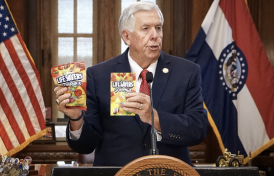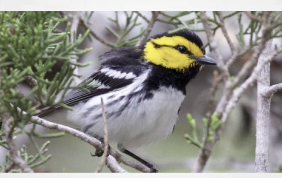- Migratory and resident forest birds in Central America are being threatened by habitat loss due to narco-trafficking activity, according to a recent study.
- Antidrug policies have pushed traditional trafficking routes in Central America into more remote, forested regions, where they threaten to destroy two-thirds of important bird landscapes.
- One-fifth of bird species that migrate to the region every year from North America have more than half of their global population within landscapes where narco-trafficking is expected to increase.
- A study co-author attributes the problem to the failed U.S.-led “war on drugs,” saying that “drug policy creates narcos and keeps them moving around.”
Every year, between November and February, the golden-cheeked warbler makes its way down from the U.S. state of Texas to Central America. But as it travels to find refuge from the winter, this tiny, endangered bird, Setophaga chrysoparia, with its bright-yellow cheeks and a buzzing song, seems unable to evade habitat loss. More than 90% of the golden-cheeked warbler population winters in a region that is at increased risk of deforestation, experts are warning.
It isn’t alone. Dozens of migratory and native forest birds in Central America could see as much as two-thirds of their habitats threatened by encroaching narco-trafficking activity that drives deforestation, according to recently published research. More than half of the migratory species analyzed had more than a quarter of their global populations in landscapes that have become more vulnerable to drug-related deforestation in Central America. And this is only for the migratory species that breed in North America, the study authors say.
They found that antidrug policies can push narco-trafficking into more remote forest areas, many of which represent important bird landscapes. Some of the areas that have become more vulnerable as a result lie within Central America’s Five Great Forests: the Maya Forest in Guatemala, the Indio-Maiz in Nicaragua, the Tortuguero in Costa Rica, and the Moskitia in Honduras. The study found that since 1970, deforestation had pushed half of the population of resident and migratory birds in the affected areas into decline.
“The degree to which we found that the most important areas for these forest residents and migratory species overlapped with areas becoming more impacted by deforestation due to drug trafficking was higher than we expected,” said study lead author Amanda Rodewald, senior director of the Center for Avian Population Studies at the Cornell Lab of Ornithology in the U.S.
“Two-thirds is pretty sizable. And I think the biggest surprise was really just how much of the global population for some of these migratory species are located or concentrated in areas that are becoming more vulnerable,” Rodewald told Mongabay. “When you’re seeing that one in five species see half of their global population impacted, we can start expecting some serious population impacts.”
Research has shown that Central America’s role in the illegal drug trade has shifted over the years, from being a transit zone for cocaine from Colombia, Peru and Bolivia destined for the U.S., to a starting point for smuggling drugs into Europe.
Study co-author Steven Sesnie, a researcher at the U.S. Fish and Wildlife Service, was the lead author of a 2017 study on cocaine trafficking and forest loss in the region that estimated drug trafficking could be responsible for 15-30% of forest loss in Nicaragua, Honduras and Guatemala, with 30-60% of forest loss occurring in protected areas. This earlier study was the first to research the impact of drug trafficking on birds in the region.
“Traffickers have begun to focus on Central America. Most of the drugs on their way to North America go through Central America,” Sesnie told Mongabay.
He added that drug traffickers are moving deeper into the rainforests of Central America due to antidrug policies, but also because clearing forests for farmland that they can sell is a means of laundering drug money. This laundering scheme and the carving-out of new smuggling routes are causing an irreversible impact on flora and fauna, according to Sesnie. “The only way to stop this is to look at the environment when you start tackling drug smuggling.”
To track which important bird landscapes are becoming exposed to what researchers call narco-deforestation, the new study used satellite imagery of deforestation in Central America, combined with modeling techniques to estimate how drug cartels are expanding their territories under pressure from antidrug policies, and then juxtaposing these data against populations of resident and migratory birds in the region. The researchers also delved into the U.S. government’s Consolidated Counterdrug Database for a better sense of how drug trafficking operates in the region.
Antidrug policies can negatively affect biodiversity and communities
According to Rodewald, antidrug policies in Central America are largely driven by or adopted from the United States. “U.S. drug policy is very supply-side focused,” she said. That puts the focus of law enforcement on intercepting the traffickers, “without considering the whole range of social processes that cause the problem. They knock it down, and the problem pops up elsewhere.”
“Narcos aren’t the problem,” said study co-author Kendra McSweeney, a geographer at Ohio State University. “Our argument is that drug policy creates narcos and keeps them moving around.”
The way authorities in the U.S. are trying to crack down on drug smuggling in Central America, historically considered their “backyard,” is counterproductive, she told Mongabay, adding that the “war on drugs” has been a disaster.
“Stop putting billions of dollars in supply-side efforts to stop the flow of drugs. They make the problem worse. Stop eradicating plantations. Stop trying to intercept the boats. Stop funding the military. Stand down,” McSweeney said. “Basically, stop having U.S. policy in Central America.”
According to her, the long-standing U.S. model of trying to keep drugs from entering communities is having a heavy impact on the region. “Use the money to invest in things that keep Central Americans at home. Instead of giving money to the military, give it to civil society. To protect forests, to invest in education.”
Read the full report at
Failed U.S. ‘war on drugs’ endangers Central American bird habitats, study warns

















